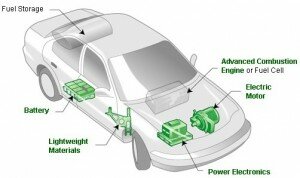Range Extender for Car
– 1 MovEnergy 45KWH Generator
– 1 Lithium Battery 10KW
– 1 Electric Motor 45KW
– 1 Fuel tank 10 L Range 1000 km
– 1 water tank 10 L
– 1 Power Electronic
Complete powertrain is about
190 kg for 1000 km Range
costs only 3 cents per kwh
excess combustion air
*complete oxidation combustor
Micro Turbine Range Extender Engine movenergy 25/65kWh
Concept and problems addressed
Range extender is an auxiliary power unit built-in or externally attached to an all-electric (BEV) or plug-in hybrid electric vehicle (PHEV) to increase its all-electric range (AER). The most commonly used range extenders are internal combustion engines that drive an electric generator which in turn supplies the battery and electric motor with electricity. The range extender can also be powered by a fuel-cell or other energy sources.
The range autonomy is one of the main barriers for the commercial success of electric vehicles, and extending the vehicle’s range when the battery is depleted helps alleviate range anxiety concerns. Plug-in hybrids with a built-in range extender unit, such as the Chevrolet Volt, are also known as extended-range electric vehicles (E-REV); and electric cars with a range-extender unit, such as the BMW i3 with such unit, are called range-extended battery-electric vehicle (BEVx) by the California Air Resources Board.
- The first generation range extenders are off the shelf internal combustion engines.
- The second generation consists of piston engines with new designs from scratch for fairly constant load in series hybrids. They include the wankel engines and rotary combustion engines and free piston engines.
- The third generation are micro turbines and fuel cells that work at constant load.

Range Extender equipment. Lotus Range Extender webpage

Range Extender equipment. Source: DLR Portal
Development and operation
One of the advantages of the plug-in hybrid design is that the generator can be completely decoupled from the traction. Unlike a conventional engine, which operates over a wide variety of power settings and operational conditions, the range extender can be operated under optimum conditions at all times. High-efficiency power sources that are not suitable for normal automotive use may be perfectly suitable for PEV use. These include advanced close-cycle steam engines, stirling engines, Wankel engines, and microturbines due primarily to their light weight and small size.

Range extender system. Source: Hybridos y electricos webpage
Costs
As a response to range anxiety concerns, BMW is offering an optional limited capability gasoline range extender engine for its all-electric BMW i3. The range-extender option costs an additional US$3,850 in the United States, €4,710 (~ US$6,300) in France, and €4,490 (~ US$6,000) in the Netherlands. The range-extender option of the BMW i3 was designed to meet the California Air Resources Board (CARB) regulation for an auxiliary power unit (APU) called REx. According to rules adopted in March 2012 by CARB, the 2014 BMW i3 with a REx unit fitted will be the first car to qualify as a range-extended battery-electric vehicle or “BEVx.” CARB describes this type of electric vehicle as “a relatively high-electric range battery-electric vehicle (BEV) to which an APU is added.” The unit, which maintains battery charge at about 30% after the pack has been depleted in normal use, is strictly limited in the additional range it can provide.



